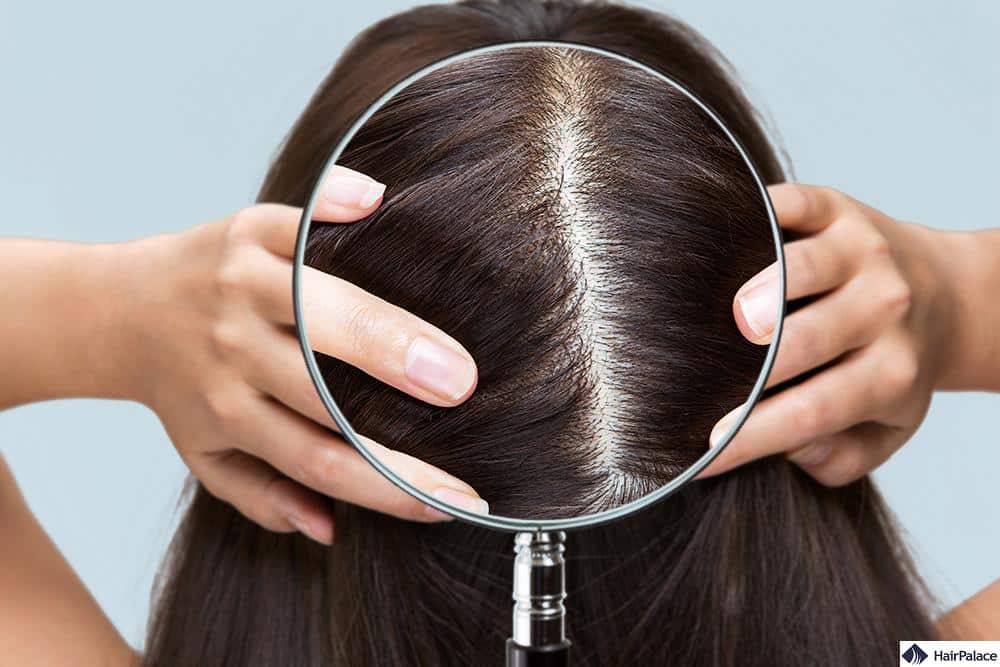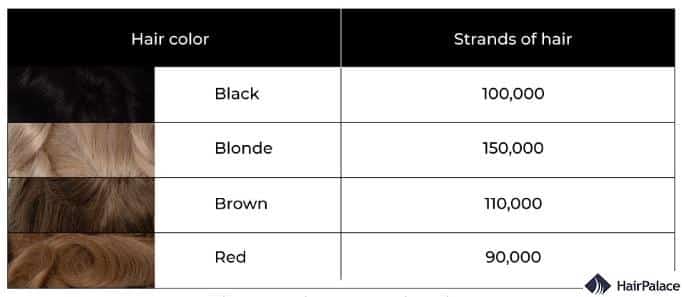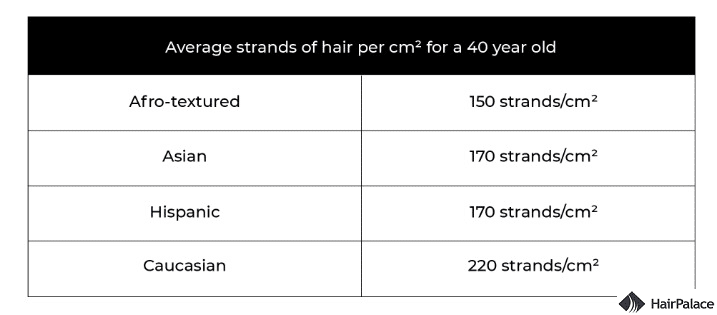How Many Hairs on a Human Head?

Have you ever looked in the mirror and wondered exactly how much hair you have? The answer may surprise you.
That’s because there are lots of different factors that can influence how much hair we can grow on our scalp and, indeed, around our bodies.
So whether you’re just curious about your hair or worried you’re losing too much, this article will take you on an exciting deep dive into hair density.
We’ll also share with you our favourite hair facts and highlight one of the essential structures of our skin that helps support hair growth – the hair follicle!
- The average number of hairs
- Hair density
- Can you increase hair density?
- Hair follicles
- Interesting facts
- Conclusion
The average number of hairs
The answer to how many hair follicles on the human head there are varies slightly from person to person.
While every person is unique, research has estimated that the average human hair count is between 100,000 to 150,000 hairs on their head.
That works out at about 124 to 200 hairs per square centimetre.
That said, many different factors can impact hair density, causing you to have more (or less) hair than someone else. These include genetics, hormones, lifestyle, environmental factors, and age.

Hair density and hair colour
Did you know there is a direct link between the color of your hair and your average hair density?
It’s estimated that blonde hair has the highest hair count, with an impressive 150,000 hair strands. Following them are brown-haired people with 110,000. Both red and black hair will have a lower density of about 90,000-100,000.
Hair density and race
Although there’s no definitive number on how much hair a certain demographic will have, research has shown a connection between your race and potential hair count.
The table below shows the average strands of hair per cm square for an average 40-year-old.
As you can see, Caucasian people have the most strands at 220 strands, with Afro-textured hair having the lowest count at 150 strands.
Both Asian and Hispanic people are somewhere in between, with 170 strands per cm squared.

You must remember, though, that every person is unique and will not have the exact same hair follicle count as the above table suggests.
Several other influencing factors can determine how much hair a person will have.
This includes hair thinning, general health, and well-being, as well as their hair care routine and sudden changes in the natural hair growth cycle.
Does gender affect hair density?
A question many people have about their hair count is how gender affects hair density.
You’ll be surprised to know that gender doesn’t really affect human hair in the ways we think.
That said, on average, men’s hair grows faster than women’s, which could be a potential reason why we often assume a man may have more hair than a woman.
Is there a way to increase hair density?
As you can see, some factors, like hair color, can dictate the estimated amount of hair per square inch on your head.
So is there a way to increase your hair count?
Unfortunately, the answer is no. We are all born with a set number of scalp hair follicles, and there’s no way to naturally increase the density.
But you can still do things to nurture and support your existing healthy hair, limiting the effects of hair loss.
Eating a healthy, nutritious diet, practising a good haircare routine, and managing stress can help sustain healthy human hair.
You can also look at cosmetic treatments, like hair transplant surgery, to redistribute existing hair follicles and combat baldness.
What can affect your hair count negatively?
Several factors can cause hair loss and early hair shedding, thus resulting in lower hair density. These include:
- Age: As people grow older, their hair’s growth rate slows, and they might experience thinning, and shedding, or if suffering from conditions like male pattern baldness, they might experience severe hair loss.
- Environmental factors: If your hair has been exposed to prolonged ultraviolet rays and harsh chemicals, or s or suffers from a hormonal imbalance, you may also lose hair on your head.
- Lifestyle factors: Poor diet and high-stress levels can also lead to hair loss. Overusing hairstyling devices like curling irons, hair straighteners, hair dyes, and perms can also damage hair follicles and cause significant hair loss.
Age aside, you can still do many things to limit or even eliminate the above risk factors, and promote healthy hair.
Managing your stress levels, eating a healthier diet rich in B Vitamins and protein, and avoiding tight hairstyles are simple but effective ways.
You can also support your existing hair using high-quality serums, shampoos, supplements, and medication to counteract hair fall.
What about hair follicles?
If you’re wondering how many hairs does a man have, then one important (and often overlooked) part of the conversation is the hair follicle.
The hair follicle is an essential part of the human head, responsible for growing new hair.
It is a tunnel-shaped structure that anchors a strand in place and supplies everything from nutrients and minerals to oxygen.
Hair follicles across your entire body are constantly progressing through what’s known as the natural growth cycle.
The 100,000 or so follicles you have on your scalp can each be in different stages of this cycle.
Below is an explanation of what each stage is about:
- The Anagen phase is the first phase when your hair follicle grows brand-new hair. About 80-90% of hairs are currently in this phase, lasting between 2 to 7 years.
- The Catagen phase is the transition phase, signalling the growth stop for that hair strand. It lasts about ten days and sees the hair cut off from its blood supply.
- The Telogen phase, also known as the resting phase, is when your hair remains dormant. It neither grows nor falls out, though new hair develops underneath. This phase can last three months, and about 10-15% of hair is in this phase at any given time.
- The Exogen phase is the fourth and final phase is the shedding phase, which sees the strand released from the follicle and falls out. After shedding, the follicle returns to the Anagen phase, and hair grows again.
Interesting facts
Here are ten facts that prove just how fascinating your hair truly is:
- Hair color is determined by genetics, with black and brown hair being dominant genes. 90% of all people have either of these two colors.
- Your hair is incredibly strong and sturdy. It can withstand as much as 3.5 ounces of force, which is impressive, given how small and thin the strands are.
- On average, your hair will grow about 12cm every year.
- Your hair can weigh up to 20% more when it’s wet.
- When wet, your hair can stretch up to 30% longer without breaking.
- Male hair will grow faster than female.
- As soon as you turn 30, the likelihood of your hair turning grey increases by 10-20% for every decade passed.
- Parts of your body that can’t grow hair include your lips, palms, hands, and soles of your feet.
- Altogether, your body may have as many as 5 million hair follicles.
- Each day, you lose between 50-100 hairs. But don’t worry – follicles constantly grow new hair to recover these losses.
Conclusion
If you’ve ever wondered how many hairs are on the average human head, now you know the answer – on average, a person will usually have about 100,000 hairs.
But as our article has shown, every person is unique, and how many hairs you have on your head can depend on everything from ethnicity to natural hair color, lifestyle, and environment.
Looking after your hair properly can give the illusion of a denser head of hair.
FAQ
Not many people realize that a certain amount of hair loss daily is perfectly normal. We stand to lose about 50-100 hairs daily as part of the natural hair growth cycle.
That said, losing a higher number of hairs than this should be a cause of concern, as you could develop an underlying condition causing hair loss.
Although every person is unique, we often estimate that the average human scalp has about 100,000 hair follicles. Hair colour is one of the biggest factors that can increase or decrease the number of follicles.
Blonde women, for example, may have more than 150,000 hair follicles on their scalp, while brown and red have lower, at about 110,000-90,000 hairs.
Each one of the hairs on your head will go through its own hair growth cycle. As such, it can be hard to know how much hair is growing daily. But on average, a person can expect to grow up to 1cm of new hair each month.
This measurement can help people estimate their hair density, as the higher the number, the more hair follicles you have covering a set space. According to research, the average person has a hair density of 124-200 hairs per square cm.
Last medically reviewed on June 11th, 2024
- Jimenez, Francisco MD1; Ruifernández, Jose M. PhD2. Distribution of Human Hair in Follicular Units: A Mathematical Model for Estimating the Donor Size in Follicular Unit Transplantation. Dermatologic Surgery 25(4):p 294-298, April 1999.https://doi.org/10.1046/j.1524-4725.1999.08114.x
- Jönsson, E.H., Bendas, J., Weidner, K. et al. The relation between human hair follicle density and touch perception. Sci Rep 7, 2499 (2017).https://doi.org/10.1038/s41598-017-02308-9
- Number of hairs on human head.https://bionumbers.hms.harvard.edu/bionumber.aspx?id=101509
- Buffoli B, Rinaldi F, Labanca M et al. The human hair: from anatomy to physiology. Int J Dermatol 2014;53: 331–341.https://doi.org/10.1111/ijd.12362


